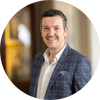
Connecting Neuroscience and Medical Education
Clinicians face constant time pressure, heavy caseloads, and a steady stream of evolving information they need to stay on top of. As medical education providers, we’re tasked with not only providing trustworthy, up-to-date scientific knowledge, but also making sure it’s delivered in ways that feel useful, engaging and easy to apply in real life.
That’s where the science of learning can really help. By grounding our approach in how the brain actually processes and remembers information, we can create more impactful learning experiences. Let’s take a look at a few key concepts from neuroscience that can help guide how we design medical education that sticks, and supports, real-world clinical application.
Neuroplasticity: How the Brain Learns and Grows1-2
One of the brain’s most remarkable abilities is neuroplasticity — its capacity to adapt by forming new neural connections or strengthening existing ones in response to experience. This adaptability means that as learning designers, we’re not just sharing facts; we’re shaping how information is retained and applied. Techniques like spaced repetition, scaffolding, and timely feedback support these brain-building processes, helping learners develop lasting, job-relevant skills. Neuroplasticity allows skill acquisition at any age, reinforces memory through repeated practice, and helps the brain compensate for decline or injury by reorganizing itself — all of which underscore its vital role in lifelong learning. Effective education isn’t just informative — it empowers clinicians to apply what they’ve learned with impact.
Cognitive Load: Making Complex Things Easier to Grasp3
Our brains are powerful, but they have limits when processing new information, which is why it’s essential to avoid overwhelming learners. Cognitive Load Theory teaches us to manage mental effort by breaking complex topics into smaller, digestible parts (intrinsic load), minimizing distractions (extraneous load), and encouraging deeper processing (germane load). When content like clinical data or treatment pathways is well-organized and simplified, it becomes easier to understand, remember, and apply in clinical practice. Multimodal strategies — using visuals, audio, and interactive elements — further support learning by distributing information across multiple senses, making the experience more engaging and effective.
Metacognition: Helping Learners Learn About Learning4-5
Good education isn’t just about delivering content — it’s about empowering people to take ownership of their learning. Metacognition, or thinking about how we think, is critical to this process. By promoting reflection, using challenge questions, and providing space to revisit ideas, we help clinicians build the self-awareness needed for stronger critical thinking, effective problem-solving, and confident decision-making in fast-paced clinical settings. Well-structured content with clear takeaways allows learners to recognize knowledge gaps and track their progress. Transparent learning objectives provide a roadmap for setting goals and guiding reflection, while self-assessment tools reinforce metacognitive skills by encouraging learners to evaluate their reasoning and adjust their approach — ultimately driving better outcomes.
ARCS: Capturing and Keeping Learner Engagement6
Even the most well-crafted content can fall flat if it doesn’t spark and sustain interest. That’s why designing for attention is the critical first step in effective learning. But attention alone isn’t enough. The ARCS model — focusing on attention, relevance, confidence and satisfaction — ensures learners stay motivated and engaged. We foster attention by minimizing distractions, using clean, intuitive visuals, and making sure our content feels directly relevant to the learner’s everyday clinical work. But to build confidence, we also need to structure learning experiences that offer clear progress, achievable challenges, and timely feedback. Interactive elements, meaningful stories (like patient cases) and well-placed questions not only keep learners focused, but they also help them feel capable and empowered as they move through the material. When learners are both engaged and confident, learning goes deeper, sticks longer, and is more likely to translate into action.
Sound and Vision: Multimedia That Works With the Brain7
Our brains process information most effectively when multiple senses are engaged — a core principle of the Cognitive Theory of Multimedia Learning. This theory, grounded in neuroscience, explains that learning improves when visual and auditory inputs are processed through distinct but complementary channels in the brain, as outlined in the dual-channel model of working memory. Instead of relying on dense text or audio alone, combining clear visuals with purposeful narration enhances comprehension and retention. Using insights from cognitive load theory and chunking, this approach leverages multiple cognitive pathways while managing mental effort. Neuroimaging studies further support this by showing that multimedia presentations activate regions like the visual and auditory cortices and the prefrontal cortex, promoting integration, working memory, and meaningful learning outcomes.
Gamification and Storytelling: Learning That Feels Alive8-10
We remember what moves us — which is why storytelling and gamification are such powerful tools in learning. Storytelling makes content relatable by embedding clinical concepts within real-world patient scenarios, creating emotional connections that enhance memory and applicability. Gamification, on the other hand, transforms learning into an engaging experience by introducing interactive case simulations, scenario-based challenges, and progress tracking. These elements promote critical thinking and active learning, allowing clinicians to safely practice complex decision-making in realistic settings. Immediate feedback and a sense of achievement further boost motivation and help learners monitor their proficiency, even in specialized or high-stakes content areas. Together, these strategies increase engagement, support long-term retention, and strengthen the connection between knowledge and practice.
Learning Together: The Power of Community11
Learning is often most effective when it’s social. By creating opportunities for collaboration — through peer discussions, expert panels, or shared case reviews — we enable healthcare professionals to exchange real-world experiences, diverse perspectives, and practical strategies. This kind of interaction not only deepens understanding and challenges assumptions but also fosters active engagement and encourages the application of new knowledge in practice. Social learning further supports professional growth by allowing learners to observe and adopt best practices from colleagues and mentors, reinforcing a culture of continuous improvement. Ultimately, it builds a strong community of practice grounded in shared learning and mutual support.
Active Learning: Practicing What Matters12-14
We know knowledge acquisition alone is insufficient. Clinicians must be able to do something with that knowledge. To address this, we build in active learning methods like simulations, real-life problem-solving and case-based tasks. These aren’t just academic exercises; they reflect the fast, often uncertain situations clinicians face daily. When learners get to practice in these realistic settings, they build confidence, sharpen skills and are better prepared for patient care.
Putting It All into Practice
At the end of the day, how we teach is just as important as what we teach. Whether it’s helping learners understand their own thinking, reducing cognitive clutter or telling stories that resonate, each approach has a key role to play in delivering education that makes a difference. By designing with intention, we support learners not only in acquiring knowledge but in applying it confidently and effectively, helping to facilitate their role in the rapid adoption of new clinical content into clinical practice, for the ultimate aim of improving patient outcomes. That’s the heart of our mission: Turning powerful learning into better clinical care.
References
- Pascual-Leone, A., & Amedi, A. (2005). Annual Review of Neuroscience, 28, 377–401
- Kolb, B., & Gibb, R. (2011). Journal of the Canadian Academy of Child and Adolescent Psychiatry, 20(4), 265–276.
- Sweller, J. (1988). Cognitive Science, 12(2), 257–285.
- Fleming, S. M., & Dolan, R. J. (2012). Philosophical Transactions of the Royal Society B: Biological Sciences, 367(1594), 1338–1349.
- Nelson, T. O., & Narens, L. (1994). Metacognition: Knowing about knowing. The MIT Press.
- Keller and Thomas 1987 An application of the ARCS model of motivational design, Instructional Theories in Action 289-319 (Hillsdale, NJ: Lawrence Erlbaum Associates).
- Mayer, R. E. (2001). Multimedia Learning. Cambridge University Press.
- Deterding, S. et al. (2011). Gamification: Toward a definition. CHI 2011 Gamification Workshop Proceedings.
- Gentry, S. V. et al. (2019). Medical Teacher, 41(10), 1097–1110.
- Yilmaz H. (2025). Anat Sci Educ, 18(3), 264-276.
- De Felice S, et al. (2021) Curr Biol, 31(21), 4853-4859.
- Prober CG, Heath C. (2013). N Engl J Med, 366, 1657–9.
- Prober CG, Khan S. (2013). Acad Med, 88, 1407–10.
- McMahon GT. (2016). N Engl J Med, 374, 1403–6.

Huw Williams, PhD, chief medical officer at PeerVoice, leads a multidisciplinary team of medical directors, educational Strategists, Writers, and Editors. With over 20 years in medical education and communications, he specializes in delivering high-quality IME/CME, offering strategic medical insight to support program development, and guiding expert teams. His background includes published doctoral and postdoctoral research in molecular life sciences, and he brings deep expertise in instructional design and adult learning principles.

Sanjay Gawade, PhD in Biomedical Sciences, is a Senior Medical Director specializing in developing IME/CME programs aimed at improving patient outcomes. He has added experience in clinical trials, including creating educational assessments focused on novel therapies. He actively contributes to advancing clinical knowledge through educational initiatives and participates in academic conferences. Known for fostering clear communication and engaging with internal and external stakeholders on innovation, he is committed to driving impactful medical education that supports clinicians in delivering better care.